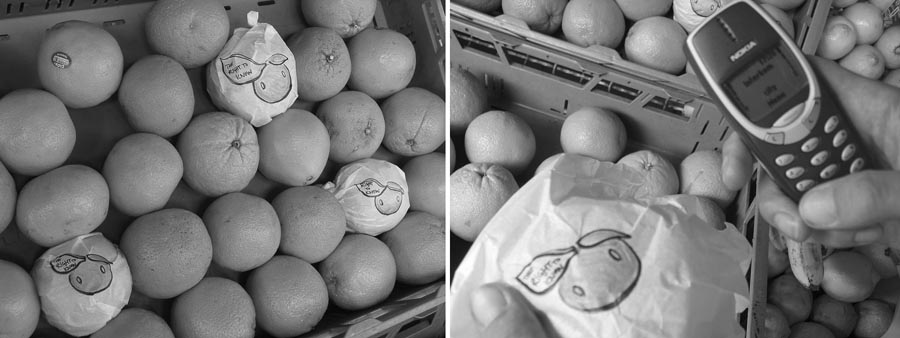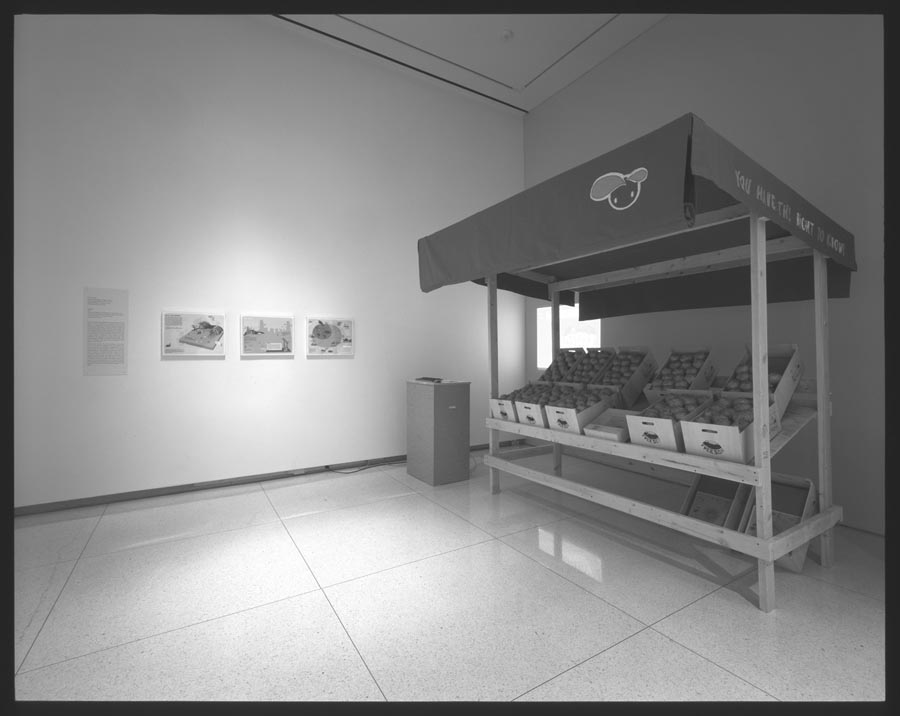F.R.U.I.T.
Installation, Smart Museum, Chicago
2005

Field Testing Wrappers
Installation, Smart Museum, Chicago
2005
So Fresh and So Green
Free Soil and the Irresistible Lure of Sustainable Design
by Tara Goe
The biggest challenge [to sustainability] is the political, social and economic systems we live in at the moment. The currents in this system are strong and don’t allow for sustainability. I use art as a means to learn, and [then] share what I learn in a visual language.
—Amy Franchescini
WEEKLY, I am blessed with the task of cataloguing all the new magazines that come into the library branch where I work, which keeps me in the loop about all things trendy and totally Brangelina and TomKat. But far more startling than the amount of covers recently dedicated to Tom and Katie’s “miracle baby” are the surplus of environmentally themed covers, featuring celebrities (and the occasional cute dog or kid) decked entirely in an earthy palette of spring greens and warm tweedy browns. Put simply, saving the environment and talking about climate change are hot right now. The most ridiculous example is Vanity Fair’s recent “Special Green Issue,” featuring Julia Roberts in full leafy-coifed earthmother drag. Newsweek also jumped on the green wagon recently with its equally earthen-tinged cover story, “The New Greening of America: From Politics to Lifestyle, Why Saving the Environment Is Suddenly Hot.”
While I’m pleased that it’s become fashionable to be eco-friendly, I can’t help feeling wary, because “hip” and “trendy” do not necessarily accessorize well with terms like “ethical” and “sustainable.” By its very definition, the word “trendy” represents everything ephemeral, temporary and completely based in the now; meanwhile, sustainable refers to the future, to creating structures in the now that will eventually become self-sustaining, allowing humanity to live (ideally) in greater harmony with its environment and available resources. So, if sustainability is becoming trendy, how do we keep its trendiness sustainable? And is that what we should be aiming for?
Beyond Green
These questions are at the forefront of my mind while viewing the catalogue for a show that opened last fall at the Smart Museum of Art in Chicago, entitled Beyond Green: Towards a Sustainable Design. It’s an impressive and inspiring collection of work—art that isn’t afraid, as stated in the catalogue, to attempt a balance of “environmental, social, economic, and aesthetic concerns.” In short, this survey of work, from the likes of Andrea Zittel, Michael Rakowitz, and Learning Group (among many others), makes sustainable living appear irresistible, necessary and just plain fun.
One of the most interesting installations in the show, F.R.U.I.T. (2005), was put together by a collaborative group called Free Soil, and focused on “the networks that link cities and agricultural areas and highlights the costs (social, economic, environmental) of getting fruit from rural areas to ever-growing populations.” Co-founded by new-media artist Amy Franceschini, founder of the artists’ group Futurefarmers, Free Soil’s main goal is not to show its work in galleries, but rather to engage the public in conversation and share information about food production and distribution. Using the orange as a focal point, group members placed wrappers in their local fruit stands, printed with information about how the food was grown and transported to the supermarket.
Franceschini explains: “By piggybacking on oranges, information was carried through the food system and into the hands of consumers. The Wrapper holds information on a variety of aspects concerning food movements, transport, and urban farming. For us, this was really the project. … In [a] gallery, the piece feels a bit staged for my liking, but I think it reached different people and in a different way than if someone found a wrapped orange in the supermarket.”
One of the things I find lovely about the project, aside from the sentiment that art can be created for truly informative purposes, is its actual aesthetic quality (along with other projects in the show). It stands as proof that a serious-minded, informative piece that champions sustainability can also be playful, and enjoyable to look at.
Franceschini’s design sense, on display at the Futurefarmers’ website and in materials and graphics for the F.R.U.I.T. project, is friendly and cute-as-a-button; but this doesn’t take away from its serious content. In fact, she makes talking about food distribution, food safety and environmental issues accessible, interactive and strangely fun. This is the lure, essentially, of much of the work in the Beyond Green show; although most of the featured artists and designers don’t consider their work to be associated with any particular movement, there is an overall playfulness to each piece— suggesting that if we are to make any move towards creating sustainable solutions within our political, social and economic systems, we must first appeal to people through aesthetics, rather than ethics. In other words, artists and designers must make the idea of sustainability look so appealing, cute and even trendy, that it will become irresistible to the general public.
Maybe, then, having Julia Roberts pose as the poster-girl for the new green lifestyle isn’t such a bad idea.
Moving Beyond Cute
I think art and activism need each other. I never think of myself as an “activist,” but if you think of activism as intentional action to bring about social or political change, then I would say that art can be activism.
—Amy Franceschini
Although I find much of the work from Beyond Green a breath of fresh air in an art world often cluttered with too many aesthetics but too few intentions, I’m still skeptical of design’s ability to create actual social change, or affect entire systems. The bourgeois trendiness of green design, seen in the popularity of the new hybrid car and the new-new prefab house, is a positive development. It’s one thing, however, to make sustainability trendy—it’s something entirely different to change people’s intentions, both their intentions in purchasing certain products and supporting environmental causes.
The artists in the Beyond Green show seem to have both their aesthetics and their intentions in the right place, but it’s ultimately up to the public to follow through with those intentions.
For more information on Amy Franceschini and Free Soil, go to freesoil.org, or futurefarmers. com. You can also download your own F.R.U.I.T. wrapper at freesoil.org/fruit/wrappers.html.
Beyond Green will be showing at the University Art Museum, Long Beach, California, November 1 through December 17, 2006; and at Smith College Museum of Art, Northampton, Massachusetts, February 2 through April 15, 2007.
Tara Goe recently learned that it’s better to buy your goods in aluminum cans than paper containers or plastic/glass bottles. She’s currently reading Gone Tomorrow: the Hidden Life of Garbage, and having a minor meltdown whenever she buys anything with excessive packaging.
